Business Research Project: Equality and Diversity at TESCO Plc, UK
VerifiedAdded on 2023/01/13
|23
|4451
|99
Project
AI Summary
This business research project investigates equality and diversity within TESCO Plc, specifically focusing on workplace gender discrimination. The project begins with an introduction outlining the background, research aims, objectives, and rational for the study, along with a timeline of activities. A comprehensive literature review explores existing research on gender discrimination, its impact on organizational performance, and related challenges. The research methodology section details the chosen qualitative approach, interpretivism philosophy, descriptive research design, and inductive approach. Data collection methods include primary and secondary sources, with a focus on thematic analysis of collected data from questionnaires. The data analysis and interpretation section presents findings related to employee awareness of gender discrimination and its prevalence within the company. The project concludes with a discussion of the findings, conclusions, and recommendations for improving workplace equality and diversity, followed by a reflective statement and a list of references and appendices including the questionnaire used.

BUSINESS RESEARCH PROJECT
1
1
Paraphrase This Document
Need a fresh take? Get an instant paraphrase of this document with our AI Paraphraser
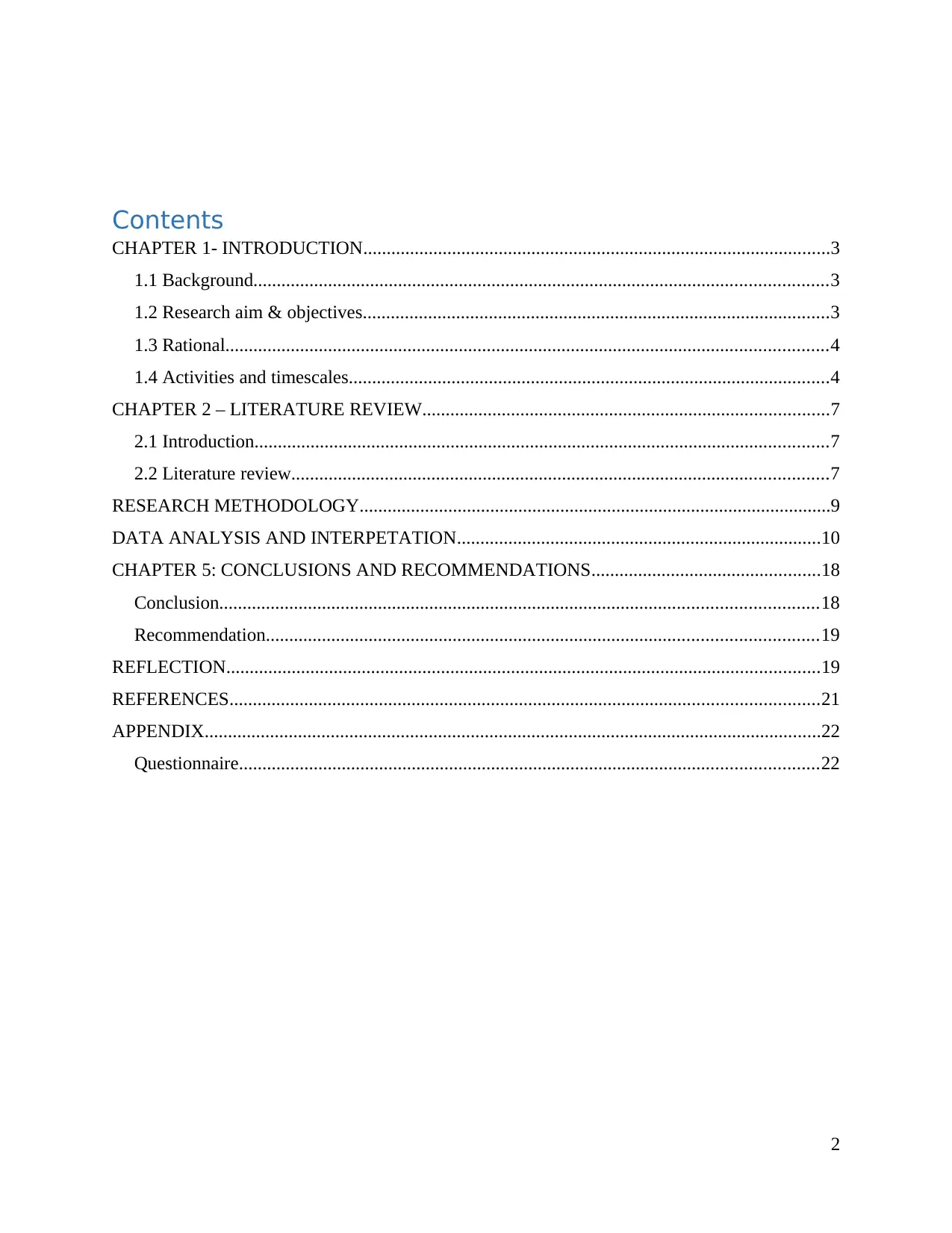
Contents
CHAPTER 1- INTRODUCTION....................................................................................................3
1.1 Background...........................................................................................................................3
1.2 Research aim & objectives....................................................................................................3
1.3 Rational.................................................................................................................................4
1.4 Activities and timescales.......................................................................................................4
CHAPTER 2 – LITERATURE REVIEW.......................................................................................7
2.1 Introduction...........................................................................................................................7
2.2 Literature review...................................................................................................................7
RESEARCH METHODOLOGY.....................................................................................................9
DATA ANALYSIS AND INTERPETATION..............................................................................10
CHAPTER 5: CONCLUSIONS AND RECOMMENDATIONS.................................................18
Conclusion................................................................................................................................18
Recommendation......................................................................................................................19
REFLECTION...............................................................................................................................19
REFERENCES..............................................................................................................................21
APPENDIX....................................................................................................................................22
Questionnaire............................................................................................................................22
2
CHAPTER 1- INTRODUCTION....................................................................................................3
1.1 Background...........................................................................................................................3
1.2 Research aim & objectives....................................................................................................3
1.3 Rational.................................................................................................................................4
1.4 Activities and timescales.......................................................................................................4
CHAPTER 2 – LITERATURE REVIEW.......................................................................................7
2.1 Introduction...........................................................................................................................7
2.2 Literature review...................................................................................................................7
RESEARCH METHODOLOGY.....................................................................................................9
DATA ANALYSIS AND INTERPETATION..............................................................................10
CHAPTER 5: CONCLUSIONS AND RECOMMENDATIONS.................................................18
Conclusion................................................................................................................................18
Recommendation......................................................................................................................19
REFLECTION...............................................................................................................................19
REFERENCES..............................................................................................................................21
APPENDIX....................................................................................................................................22
Questionnaire............................................................................................................................22
2
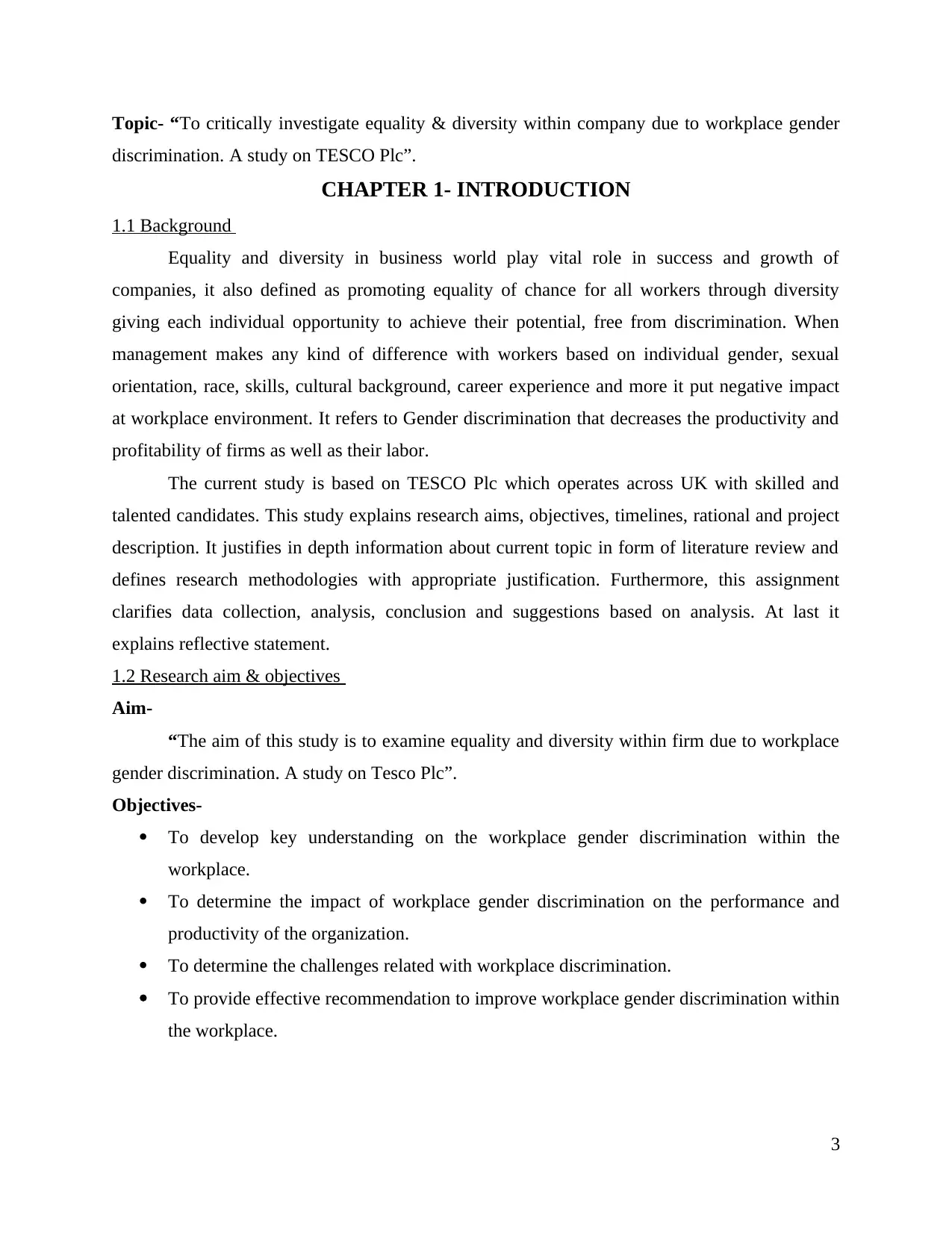
Topic- “To critically investigate equality & diversity within company due to workplace gender
discrimination. A study on TESCO Plc”.
CHAPTER 1- INTRODUCTION
1.1 Background
Equality and diversity in business world play vital role in success and growth of
companies, it also defined as promoting equality of chance for all workers through diversity
giving each individual opportunity to achieve their potential, free from discrimination. When
management makes any kind of difference with workers based on individual gender, sexual
orientation, race, skills, cultural background, career experience and more it put negative impact
at workplace environment. It refers to Gender discrimination that decreases the productivity and
profitability of firms as well as their labor.
The current study is based on TESCO Plc which operates across UK with skilled and
talented candidates. This study explains research aims, objectives, timelines, rational and project
description. It justifies in depth information about current topic in form of literature review and
defines research methodologies with appropriate justification. Furthermore, this assignment
clarifies data collection, analysis, conclusion and suggestions based on analysis. At last it
explains reflective statement.
1.2 Research aim & objectives
Aim-
“The aim of this study is to examine equality and diversity within firm due to workplace
gender discrimination. A study on Tesco Plc”.
Objectives-
To develop key understanding on the workplace gender discrimination within the
workplace.
To determine the impact of workplace gender discrimination on the performance and
productivity of the organization.
To determine the challenges related with workplace discrimination.
To provide effective recommendation to improve workplace gender discrimination within
the workplace.
3
discrimination. A study on TESCO Plc”.
CHAPTER 1- INTRODUCTION
1.1 Background
Equality and diversity in business world play vital role in success and growth of
companies, it also defined as promoting equality of chance for all workers through diversity
giving each individual opportunity to achieve their potential, free from discrimination. When
management makes any kind of difference with workers based on individual gender, sexual
orientation, race, skills, cultural background, career experience and more it put negative impact
at workplace environment. It refers to Gender discrimination that decreases the productivity and
profitability of firms as well as their labor.
The current study is based on TESCO Plc which operates across UK with skilled and
talented candidates. This study explains research aims, objectives, timelines, rational and project
description. It justifies in depth information about current topic in form of literature review and
defines research methodologies with appropriate justification. Furthermore, this assignment
clarifies data collection, analysis, conclusion and suggestions based on analysis. At last it
explains reflective statement.
1.2 Research aim & objectives
Aim-
“The aim of this study is to examine equality and diversity within firm due to workplace
gender discrimination. A study on Tesco Plc”.
Objectives-
To develop key understanding on the workplace gender discrimination within the
workplace.
To determine the impact of workplace gender discrimination on the performance and
productivity of the organization.
To determine the challenges related with workplace discrimination.
To provide effective recommendation to improve workplace gender discrimination within
the workplace.
3
⊘ This is a preview!⊘
Do you want full access?
Subscribe today to unlock all pages.

Trusted by 1+ million students worldwide
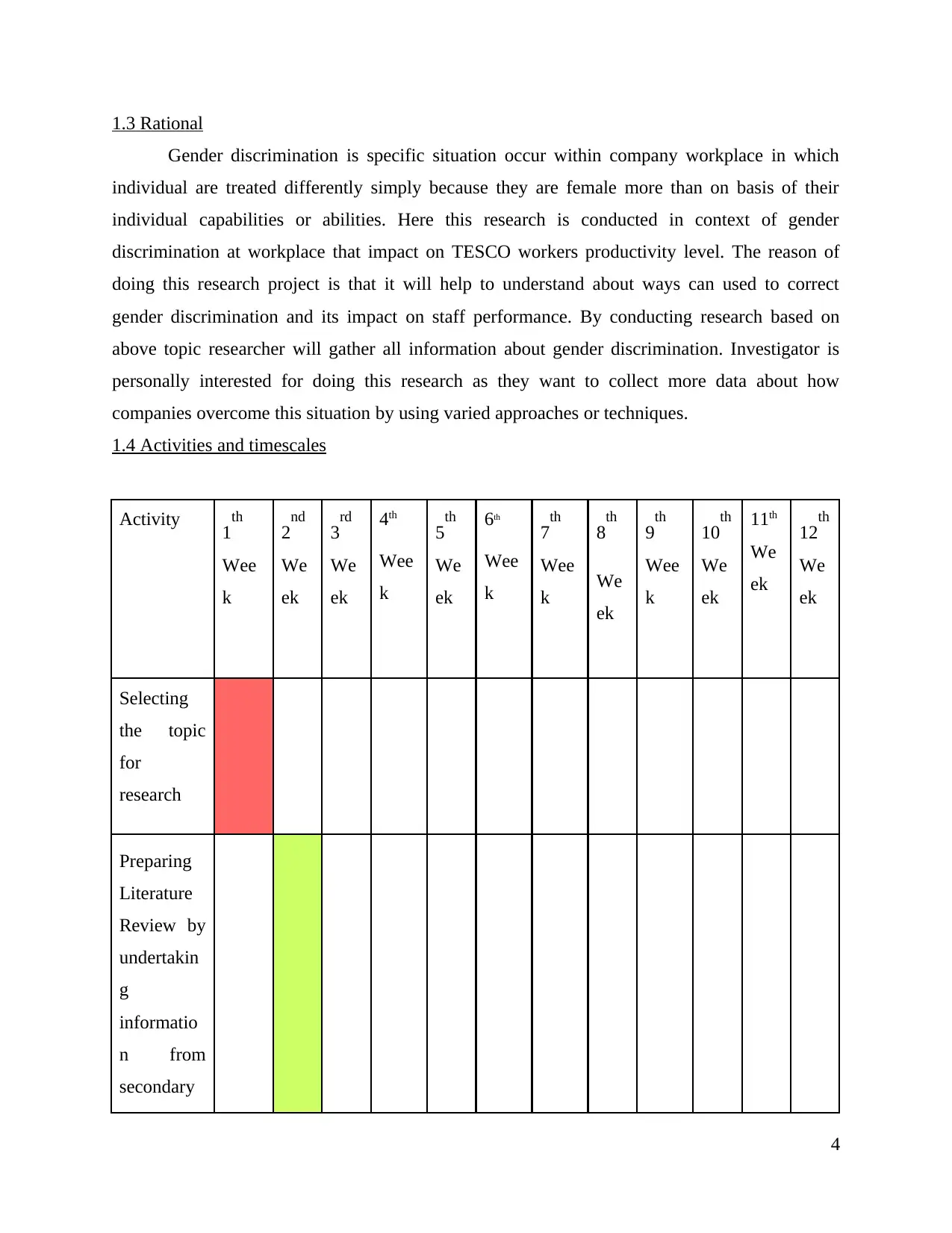
1.3 Rational
Gender discrimination is specific situation occur within company workplace in which
individual are treated differently simply because they are female more than on basis of their
individual capabilities or abilities. Here this research is conducted in context of gender
discrimination at workplace that impact on TESCO workers productivity level. The reason of
doing this research project is that it will help to understand about ways can used to correct
gender discrimination and its impact on staff performance. By conducting research based on
above topic researcher will gather all information about gender discrimination. Investigator is
personally interested for doing this research as they want to collect more data about how
companies overcome this situation by using varied approaches or techniques.
1.4 Activities and timescales
Activity 1th
Wee
k
2nd
We
ek
3rd
We
ek
4th
Wee
k
5th
We
ek
6th
Wee
k
7th
Wee
k
8th
We
ek
9th
Wee
k
10th
We
ek
11th
We
ek
12th
We
ek
Selecting
the topic
for
research
Preparing
Literature
Review by
undertakin
g
informatio
n from
secondary
4
Gender discrimination is specific situation occur within company workplace in which
individual are treated differently simply because they are female more than on basis of their
individual capabilities or abilities. Here this research is conducted in context of gender
discrimination at workplace that impact on TESCO workers productivity level. The reason of
doing this research project is that it will help to understand about ways can used to correct
gender discrimination and its impact on staff performance. By conducting research based on
above topic researcher will gather all information about gender discrimination. Investigator is
personally interested for doing this research as they want to collect more data about how
companies overcome this situation by using varied approaches or techniques.
1.4 Activities and timescales
Activity 1th
Wee
k
2nd
We
ek
3rd
We
ek
4th
Wee
k
5th
We
ek
6th
Wee
k
7th
Wee
k
8th
We
ek
9th
Wee
k
10th
We
ek
11th
We
ek
12th
We
ek
Selecting
the topic
for
research
Preparing
Literature
Review by
undertakin
g
informatio
n from
secondary
4
Paraphrase This Document
Need a fresh take? Get an instant paraphrase of this document with our AI Paraphraser

sources
Methods
used to
conduct
research
Methodolo
gy
Identifying
the
relevant
factors
Preparing
Questionna
ire to
examine
the actual
informatio
n
Collects
facts and
data of that
topic.
Analysed
them by
using
thematic
5
Methods
used to
conduct
research
Methodolo
gy
Identifying
the
relevant
factors
Preparing
Questionna
ire to
examine
the actual
informatio
n
Collects
facts and
data of that
topic.
Analysed
them by
using
thematic
5
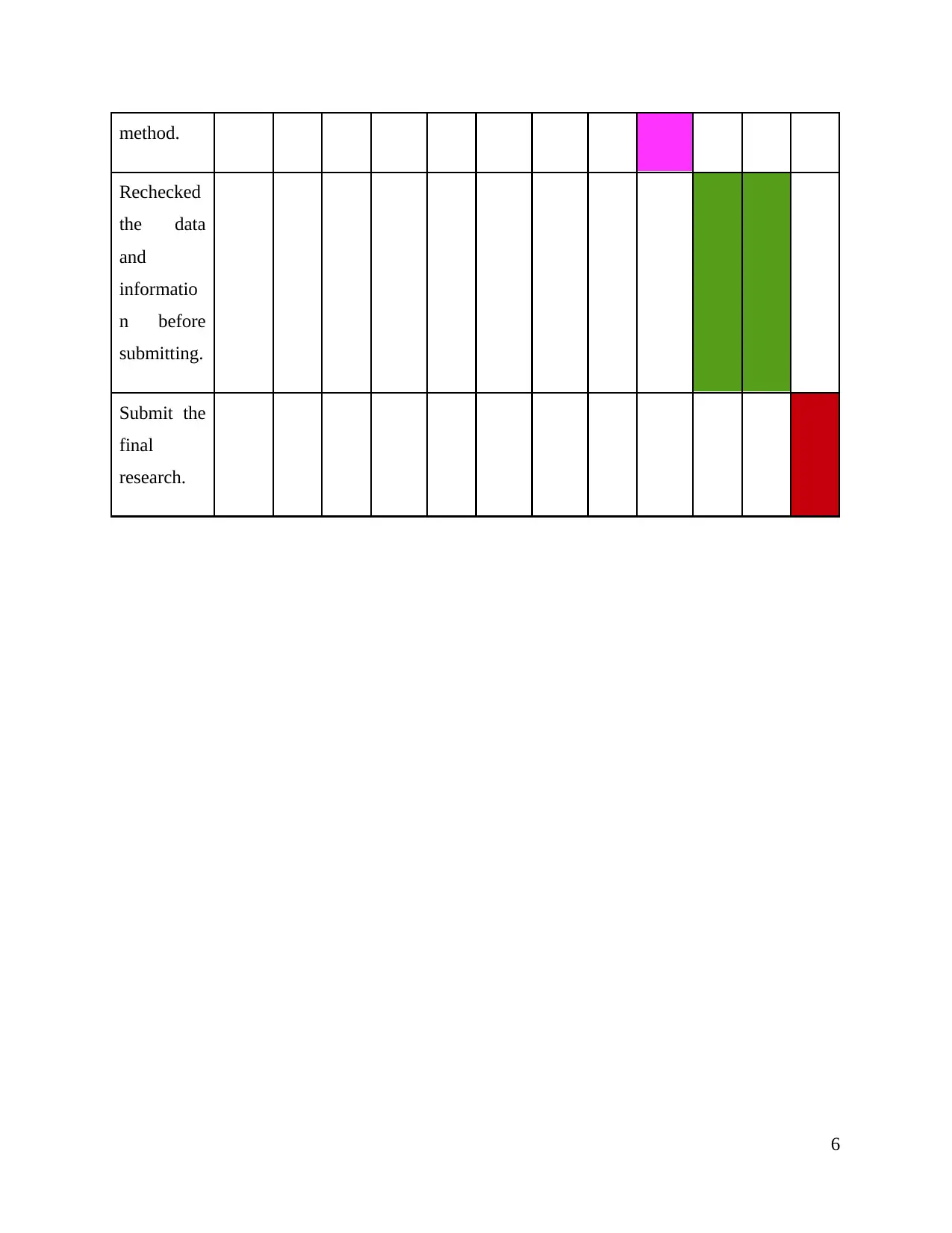
method.
Rechecked
the data
and
informatio
n before
submitting.
Submit the
final
research.
6
Rechecked
the data
and
informatio
n before
submitting.
Submit the
final
research.
6
⊘ This is a preview!⊘
Do you want full access?
Subscribe today to unlock all pages.

Trusted by 1+ million students worldwide
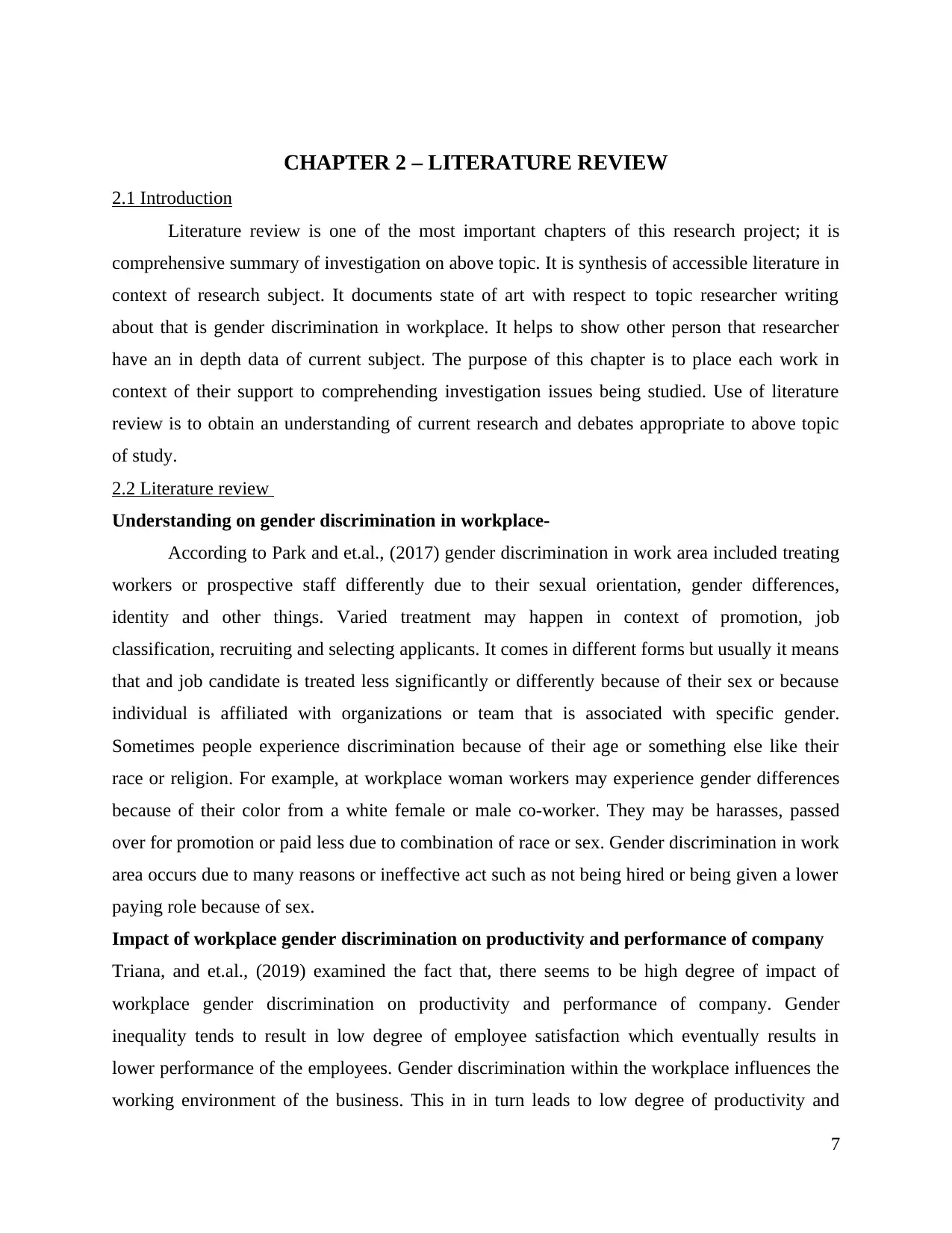
CHAPTER 2 – LITERATURE REVIEW
2.1 Introduction
Literature review is one of the most important chapters of this research project; it is
comprehensive summary of investigation on above topic. It is synthesis of accessible literature in
context of research subject. It documents state of art with respect to topic researcher writing
about that is gender discrimination in workplace. It helps to show other person that researcher
have an in depth data of current subject. The purpose of this chapter is to place each work in
context of their support to comprehending investigation issues being studied. Use of literature
review is to obtain an understanding of current research and debates appropriate to above topic
of study.
2.2 Literature review
Understanding on gender discrimination in workplace-
According to Park and et.al., (2017) gender discrimination in work area included treating
workers or prospective staff differently due to their sexual orientation, gender differences,
identity and other things. Varied treatment may happen in context of promotion, job
classification, recruiting and selecting applicants. It comes in different forms but usually it means
that and job candidate is treated less significantly or differently because of their sex or because
individual is affiliated with organizations or team that is associated with specific gender.
Sometimes people experience discrimination because of their age or something else like their
race or religion. For example, at workplace woman workers may experience gender differences
because of their color from a white female or male co-worker. They may be harasses, passed
over for promotion or paid less due to combination of race or sex. Gender discrimination in work
area occurs due to many reasons or ineffective act such as not being hired or being given a lower
paying role because of sex.
Impact of workplace gender discrimination on productivity and performance of company
Triana, and et.al., (2019) examined the fact that, there seems to be high degree of impact of
workplace gender discrimination on productivity and performance of company. Gender
inequality tends to result in low degree of employee satisfaction which eventually results in
lower performance of the employees. Gender discrimination within the workplace influences the
working environment of the business. This in in turn leads to low degree of productivity and
7
2.1 Introduction
Literature review is one of the most important chapters of this research project; it is
comprehensive summary of investigation on above topic. It is synthesis of accessible literature in
context of research subject. It documents state of art with respect to topic researcher writing
about that is gender discrimination in workplace. It helps to show other person that researcher
have an in depth data of current subject. The purpose of this chapter is to place each work in
context of their support to comprehending investigation issues being studied. Use of literature
review is to obtain an understanding of current research and debates appropriate to above topic
of study.
2.2 Literature review
Understanding on gender discrimination in workplace-
According to Park and et.al., (2017) gender discrimination in work area included treating
workers or prospective staff differently due to their sexual orientation, gender differences,
identity and other things. Varied treatment may happen in context of promotion, job
classification, recruiting and selecting applicants. It comes in different forms but usually it means
that and job candidate is treated less significantly or differently because of their sex or because
individual is affiliated with organizations or team that is associated with specific gender.
Sometimes people experience discrimination because of their age or something else like their
race or religion. For example, at workplace woman workers may experience gender differences
because of their color from a white female or male co-worker. They may be harasses, passed
over for promotion or paid less due to combination of race or sex. Gender discrimination in work
area occurs due to many reasons or ineffective act such as not being hired or being given a lower
paying role because of sex.
Impact of workplace gender discrimination on productivity and performance of company
Triana, and et.al., (2019) examined the fact that, there seems to be high degree of impact of
workplace gender discrimination on productivity and performance of company. Gender
inequality tends to result in low degree of employee satisfaction which eventually results in
lower performance of the employees. Gender discrimination within the workplace influences the
working environment of the business. This in in turn leads to low degree of productivity and
7
Paraphrase This Document
Need a fresh take? Get an instant paraphrase of this document with our AI Paraphraser
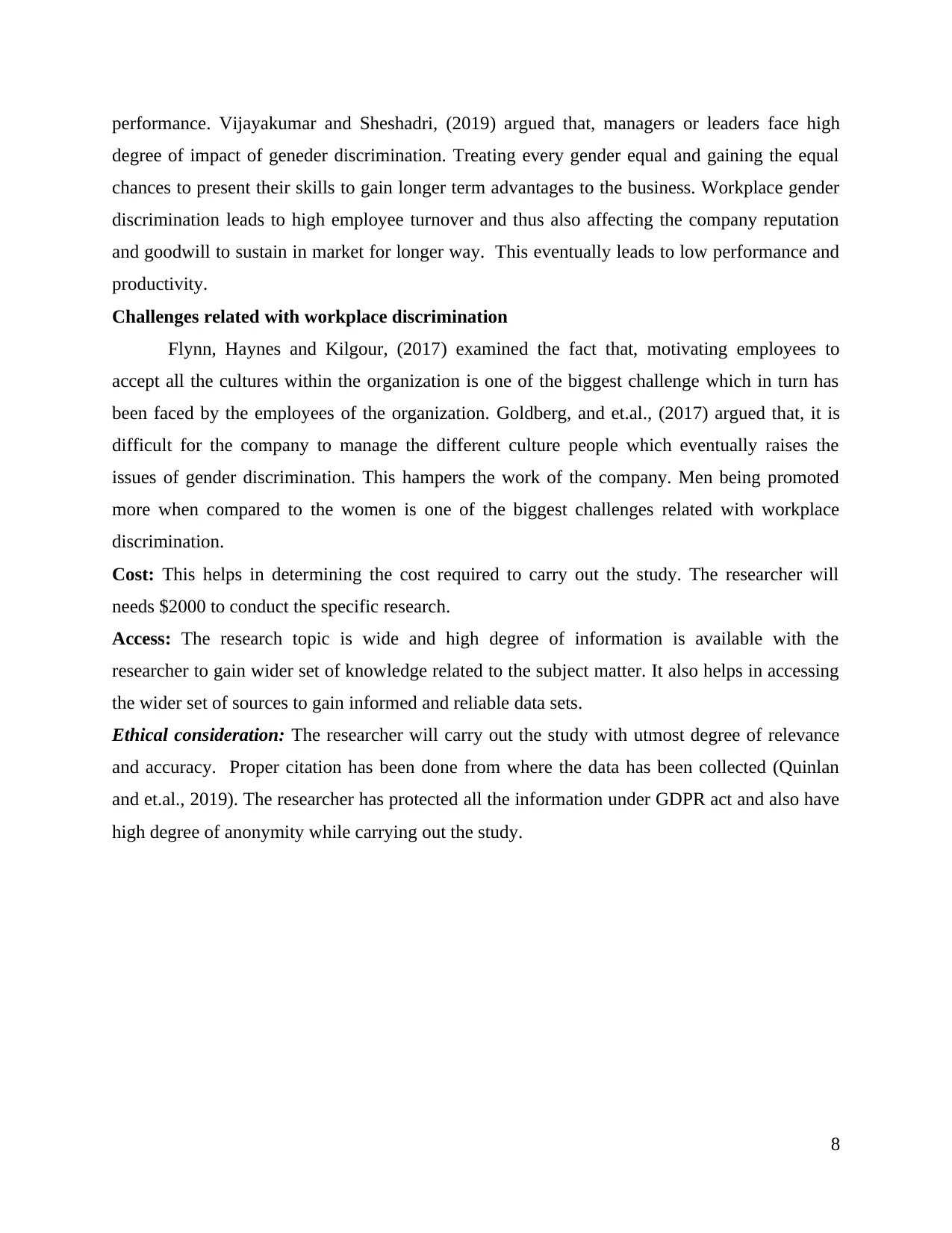
performance. Vijayakumar and Sheshadri, (2019) argued that, managers or leaders face high
degree of impact of geneder discrimination. Treating every gender equal and gaining the equal
chances to present their skills to gain longer term advantages to the business. Workplace gender
discrimination leads to high employee turnover and thus also affecting the company reputation
and goodwill to sustain in market for longer way. This eventually leads to low performance and
productivity.
Challenges related with workplace discrimination
Flynn, Haynes and Kilgour, (2017) examined the fact that, motivating employees to
accept all the cultures within the organization is one of the biggest challenge which in turn has
been faced by the employees of the organization. Goldberg, and et.al., (2017) argued that, it is
difficult for the company to manage the different culture people which eventually raises the
issues of gender discrimination. This hampers the work of the company. Men being promoted
more when compared to the women is one of the biggest challenges related with workplace
discrimination.
Cost: This helps in determining the cost required to carry out the study. The researcher will
needs $2000 to conduct the specific research.
Access: The research topic is wide and high degree of information is available with the
researcher to gain wider set of knowledge related to the subject matter. It also helps in accessing
the wider set of sources to gain informed and reliable data sets.
Ethical consideration: The researcher will carry out the study with utmost degree of relevance
and accuracy. Proper citation has been done from where the data has been collected (Quinlan
and et.al., 2019). The researcher has protected all the information under GDPR act and also have
high degree of anonymity while carrying out the study.
8
degree of impact of geneder discrimination. Treating every gender equal and gaining the equal
chances to present their skills to gain longer term advantages to the business. Workplace gender
discrimination leads to high employee turnover and thus also affecting the company reputation
and goodwill to sustain in market for longer way. This eventually leads to low performance and
productivity.
Challenges related with workplace discrimination
Flynn, Haynes and Kilgour, (2017) examined the fact that, motivating employees to
accept all the cultures within the organization is one of the biggest challenge which in turn has
been faced by the employees of the organization. Goldberg, and et.al., (2017) argued that, it is
difficult for the company to manage the different culture people which eventually raises the
issues of gender discrimination. This hampers the work of the company. Men being promoted
more when compared to the women is one of the biggest challenges related with workplace
discrimination.
Cost: This helps in determining the cost required to carry out the study. The researcher will
needs $2000 to conduct the specific research.
Access: The research topic is wide and high degree of information is available with the
researcher to gain wider set of knowledge related to the subject matter. It also helps in accessing
the wider set of sources to gain informed and reliable data sets.
Ethical consideration: The researcher will carry out the study with utmost degree of relevance
and accuracy. Proper citation has been done from where the data has been collected (Quinlan
and et.al., 2019). The researcher has protected all the information under GDPR act and also have
high degree of anonymity while carrying out the study.
8
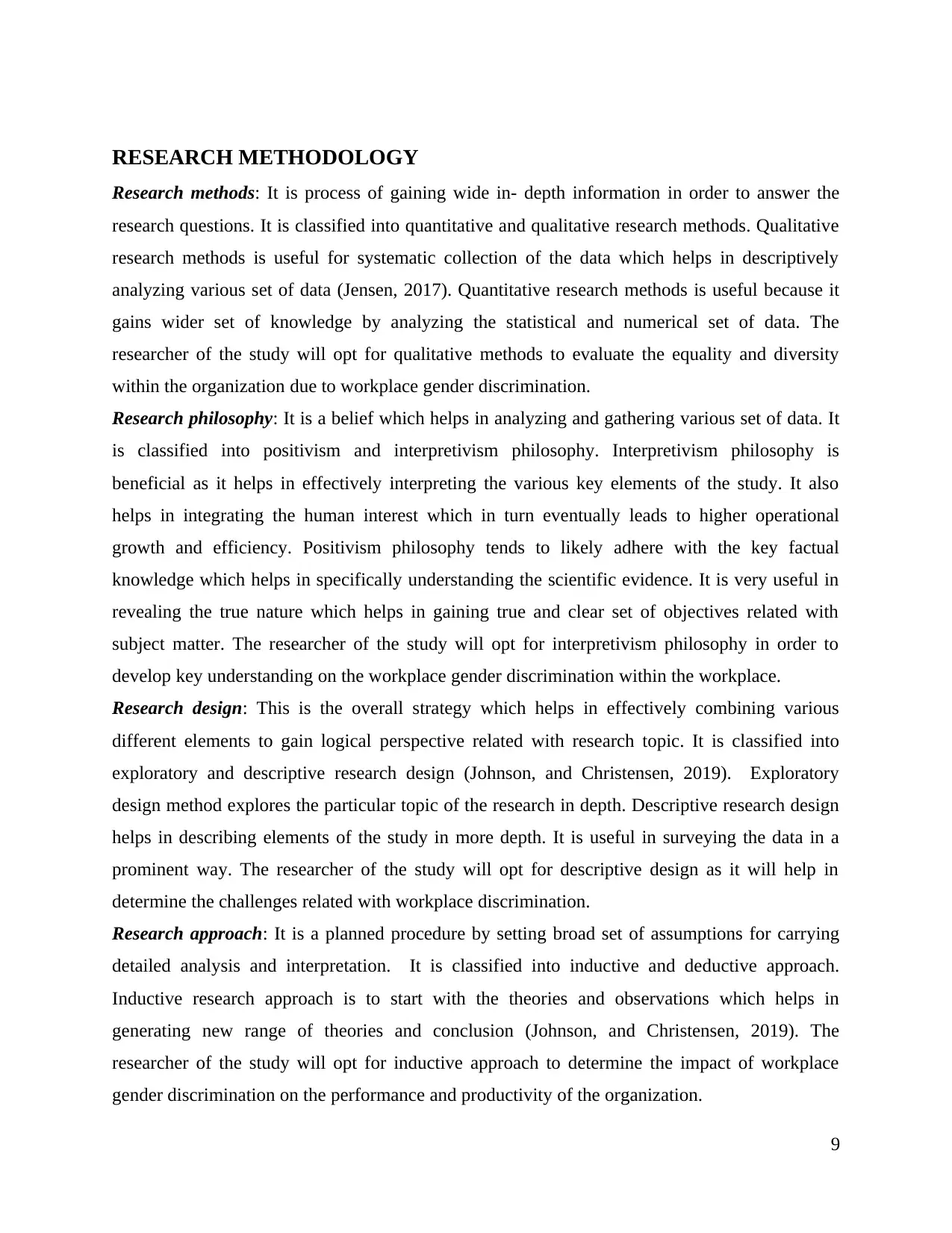
RESEARCH METHODOLOGY
Research methods: It is process of gaining wide in- depth information in order to answer the
research questions. It is classified into quantitative and qualitative research methods. Qualitative
research methods is useful for systematic collection of the data which helps in descriptively
analyzing various set of data (Jensen, 2017). Quantitative research methods is useful because it
gains wider set of knowledge by analyzing the statistical and numerical set of data. The
researcher of the study will opt for qualitative methods to evaluate the equality and diversity
within the organization due to workplace gender discrimination.
Research philosophy: It is a belief which helps in analyzing and gathering various set of data. It
is classified into positivism and interpretivism philosophy. Interpretivism philosophy is
beneficial as it helps in effectively interpreting the various key elements of the study. It also
helps in integrating the human interest which in turn eventually leads to higher operational
growth and efficiency. Positivism philosophy tends to likely adhere with the key factual
knowledge which helps in specifically understanding the scientific evidence. It is very useful in
revealing the true nature which helps in gaining true and clear set of objectives related with
subject matter. The researcher of the study will opt for interpretivism philosophy in order to
develop key understanding on the workplace gender discrimination within the workplace.
Research design: This is the overall strategy which helps in effectively combining various
different elements to gain logical perspective related with research topic. It is classified into
exploratory and descriptive research design (Johnson, and Christensen, 2019). Exploratory
design method explores the particular topic of the research in depth. Descriptive research design
helps in describing elements of the study in more depth. It is useful in surveying the data in a
prominent way. The researcher of the study will opt for descriptive design as it will help in
determine the challenges related with workplace discrimination.
Research approach: It is a planned procedure by setting broad set of assumptions for carrying
detailed analysis and interpretation. It is classified into inductive and deductive approach.
Inductive research approach is to start with the theories and observations which helps in
generating new range of theories and conclusion (Johnson, and Christensen, 2019). The
researcher of the study will opt for inductive approach to determine the impact of workplace
gender discrimination on the performance and productivity of the organization.
9
Research methods: It is process of gaining wide in- depth information in order to answer the
research questions. It is classified into quantitative and qualitative research methods. Qualitative
research methods is useful for systematic collection of the data which helps in descriptively
analyzing various set of data (Jensen, 2017). Quantitative research methods is useful because it
gains wider set of knowledge by analyzing the statistical and numerical set of data. The
researcher of the study will opt for qualitative methods to evaluate the equality and diversity
within the organization due to workplace gender discrimination.
Research philosophy: It is a belief which helps in analyzing and gathering various set of data. It
is classified into positivism and interpretivism philosophy. Interpretivism philosophy is
beneficial as it helps in effectively interpreting the various key elements of the study. It also
helps in integrating the human interest which in turn eventually leads to higher operational
growth and efficiency. Positivism philosophy tends to likely adhere with the key factual
knowledge which helps in specifically understanding the scientific evidence. It is very useful in
revealing the true nature which helps in gaining true and clear set of objectives related with
subject matter. The researcher of the study will opt for interpretivism philosophy in order to
develop key understanding on the workplace gender discrimination within the workplace.
Research design: This is the overall strategy which helps in effectively combining various
different elements to gain logical perspective related with research topic. It is classified into
exploratory and descriptive research design (Johnson, and Christensen, 2019). Exploratory
design method explores the particular topic of the research in depth. Descriptive research design
helps in describing elements of the study in more depth. It is useful in surveying the data in a
prominent way. The researcher of the study will opt for descriptive design as it will help in
determine the challenges related with workplace discrimination.
Research approach: It is a planned procedure by setting broad set of assumptions for carrying
detailed analysis and interpretation. It is classified into inductive and deductive approach.
Inductive research approach is to start with the theories and observations which helps in
generating new range of theories and conclusion (Johnson, and Christensen, 2019). The
researcher of the study will opt for inductive approach to determine the impact of workplace
gender discrimination on the performance and productivity of the organization.
9
⊘ This is a preview!⊘
Do you want full access?
Subscribe today to unlock all pages.

Trusted by 1+ million students worldwide
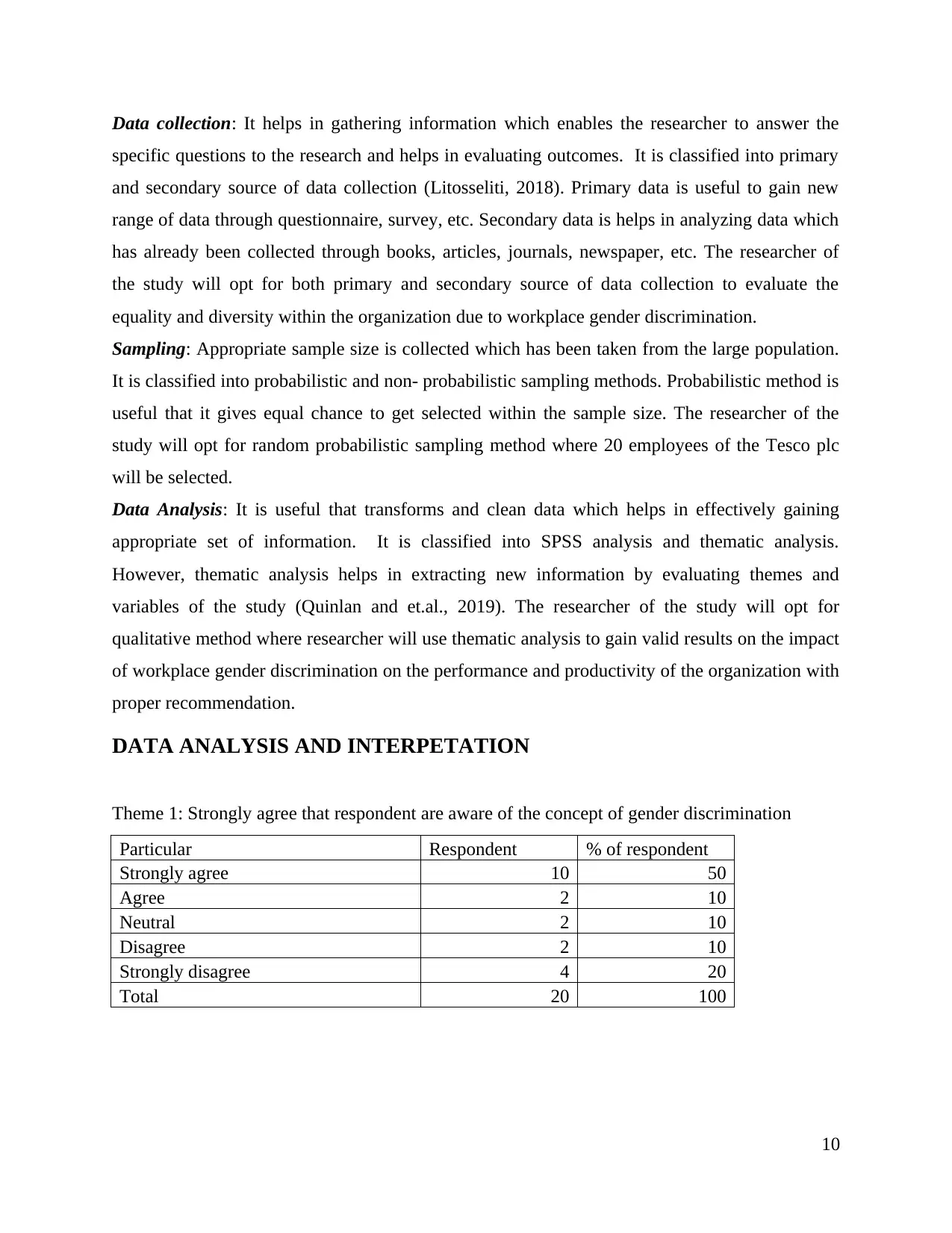
Data collection: It helps in gathering information which enables the researcher to answer the
specific questions to the research and helps in evaluating outcomes. It is classified into primary
and secondary source of data collection (Litosseliti, 2018). Primary data is useful to gain new
range of data through questionnaire, survey, etc. Secondary data is helps in analyzing data which
has already been collected through books, articles, journals, newspaper, etc. The researcher of
the study will opt for both primary and secondary source of data collection to evaluate the
equality and diversity within the organization due to workplace gender discrimination.
Sampling: Appropriate sample size is collected which has been taken from the large population.
It is classified into probabilistic and non- probabilistic sampling methods. Probabilistic method is
useful that it gives equal chance to get selected within the sample size. The researcher of the
study will opt for random probabilistic sampling method where 20 employees of the Tesco plc
will be selected.
Data Analysis: It is useful that transforms and clean data which helps in effectively gaining
appropriate set of information. It is classified into SPSS analysis and thematic analysis.
However, thematic analysis helps in extracting new information by evaluating themes and
variables of the study (Quinlan and et.al., 2019). The researcher of the study will opt for
qualitative method where researcher will use thematic analysis to gain valid results on the impact
of workplace gender discrimination on the performance and productivity of the organization with
proper recommendation.
DATA ANALYSIS AND INTERPETATION
Theme 1: Strongly agree that respondent are aware of the concept of gender discrimination
Particular Respondent % of respondent
Strongly agree 10 50
Agree 2 10
Neutral 2 10
Disagree 2 10
Strongly disagree 4 20
Total 20 100
10
specific questions to the research and helps in evaluating outcomes. It is classified into primary
and secondary source of data collection (Litosseliti, 2018). Primary data is useful to gain new
range of data through questionnaire, survey, etc. Secondary data is helps in analyzing data which
has already been collected through books, articles, journals, newspaper, etc. The researcher of
the study will opt for both primary and secondary source of data collection to evaluate the
equality and diversity within the organization due to workplace gender discrimination.
Sampling: Appropriate sample size is collected which has been taken from the large population.
It is classified into probabilistic and non- probabilistic sampling methods. Probabilistic method is
useful that it gives equal chance to get selected within the sample size. The researcher of the
study will opt for random probabilistic sampling method where 20 employees of the Tesco plc
will be selected.
Data Analysis: It is useful that transforms and clean data which helps in effectively gaining
appropriate set of information. It is classified into SPSS analysis and thematic analysis.
However, thematic analysis helps in extracting new information by evaluating themes and
variables of the study (Quinlan and et.al., 2019). The researcher of the study will opt for
qualitative method where researcher will use thematic analysis to gain valid results on the impact
of workplace gender discrimination on the performance and productivity of the organization with
proper recommendation.
DATA ANALYSIS AND INTERPETATION
Theme 1: Strongly agree that respondent are aware of the concept of gender discrimination
Particular Respondent % of respondent
Strongly agree 10 50
Agree 2 10
Neutral 2 10
Disagree 2 10
Strongly disagree 4 20
Total 20 100
10
Paraphrase This Document
Need a fresh take? Get an instant paraphrase of this document with our AI Paraphraser
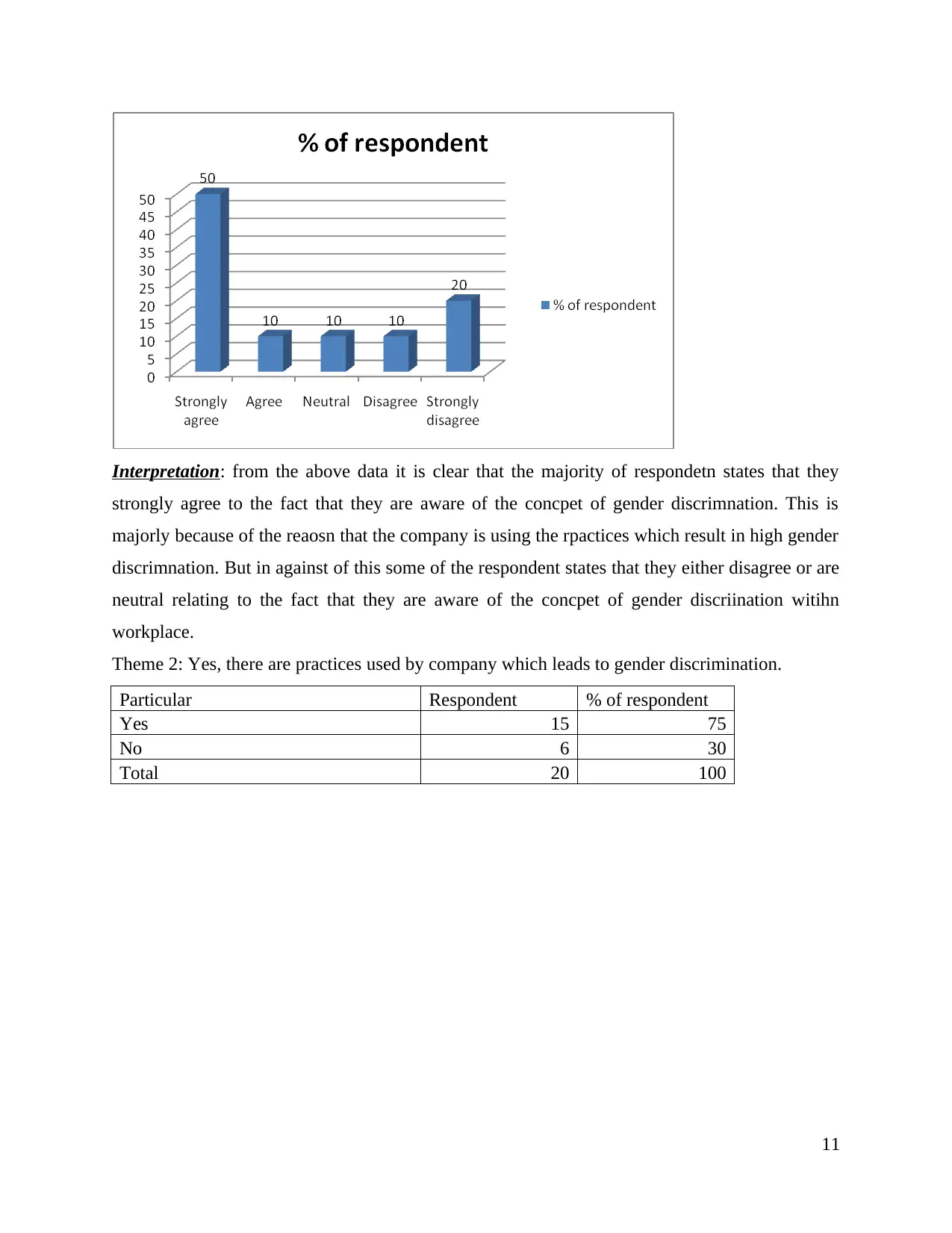
Interpretation: from the above data it is clear that the majority of respondetn states that they
strongly agree to the fact that they are aware of the concpet of gender discrimnation. This is
majorly because of the reaosn that the company is using the rpactices which result in high gender
discrimnation. But in against of this some of the respondent states that they either disagree or are
neutral relating to the fact that they are aware of the concpet of gender discriination witihn
workplace.
Theme 2: Yes, there are practices used by company which leads to gender discrimination.
Particular Respondent % of respondent
Yes 15 75
No 6 30
Total 20 100
11
strongly agree to the fact that they are aware of the concpet of gender discrimnation. This is
majorly because of the reaosn that the company is using the rpactices which result in high gender
discrimnation. But in against of this some of the respondent states that they either disagree or are
neutral relating to the fact that they are aware of the concpet of gender discriination witihn
workplace.
Theme 2: Yes, there are practices used by company which leads to gender discrimination.
Particular Respondent % of respondent
Yes 15 75
No 6 30
Total 20 100
11
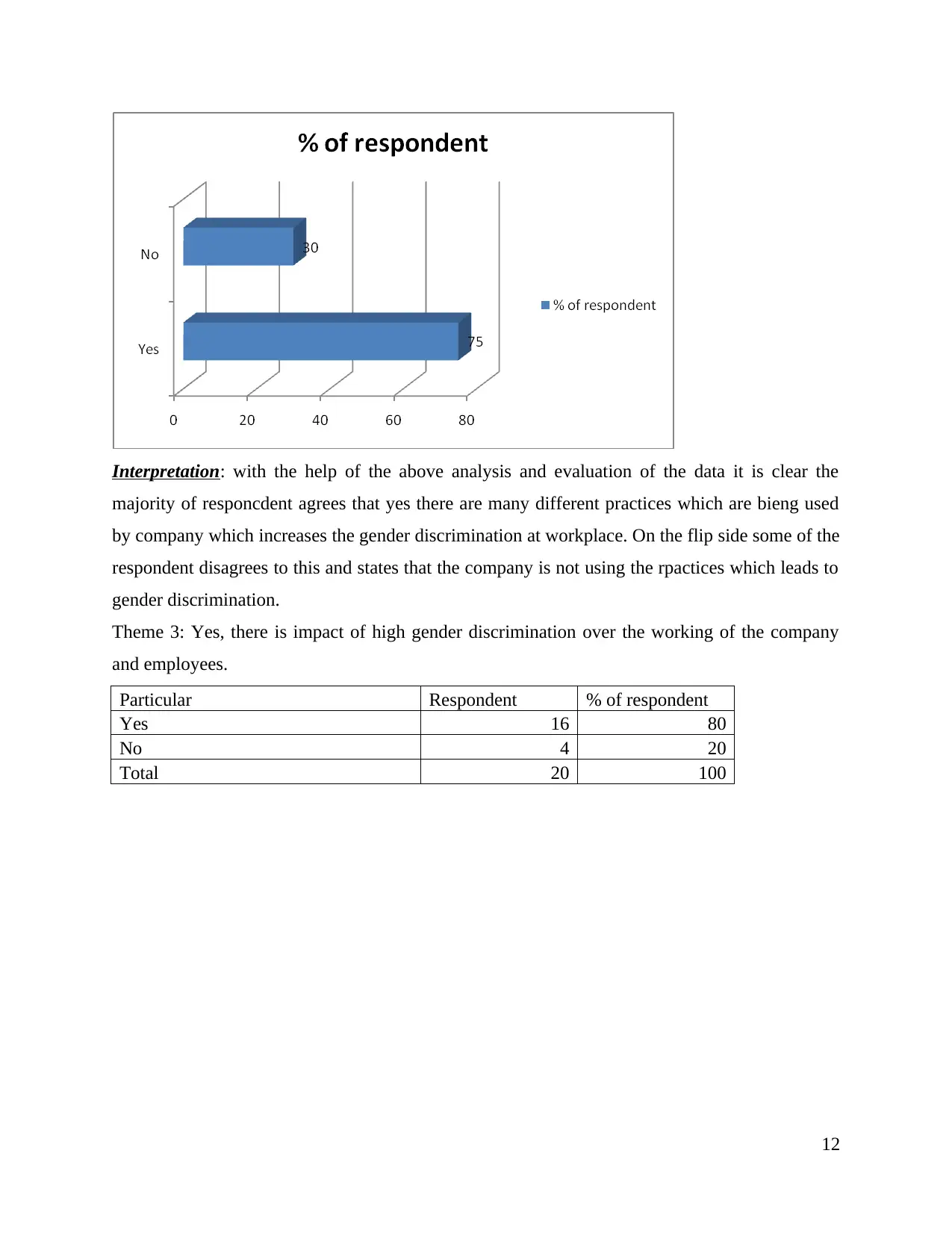
Interpretation: with the help of the above analysis and evaluation of the data it is clear the
majority of responcdent agrees that yes there are many different practices which are bieng used
by company which increases the gender discrimination at workplace. On the flip side some of the
respondent disagrees to this and states that the company is not using the rpactices which leads to
gender discrimination.
Theme 3: Yes, there is impact of high gender discrimination over the working of the company
and employees.
Particular Respondent % of respondent
Yes 16 80
No 4 20
Total 20 100
12
majority of responcdent agrees that yes there are many different practices which are bieng used
by company which increases the gender discrimination at workplace. On the flip side some of the
respondent disagrees to this and states that the company is not using the rpactices which leads to
gender discrimination.
Theme 3: Yes, there is impact of high gender discrimination over the working of the company
and employees.
Particular Respondent % of respondent
Yes 16 80
No 4 20
Total 20 100
12
⊘ This is a preview!⊘
Do you want full access?
Subscribe today to unlock all pages.

Trusted by 1+ million students worldwide
1 out of 23
Related Documents
Your All-in-One AI-Powered Toolkit for Academic Success.
+13062052269
info@desklib.com
Available 24*7 on WhatsApp / Email
![[object Object]](/_next/static/media/star-bottom.7253800d.svg)
Unlock your academic potential
Copyright © 2020–2025 A2Z Services. All Rights Reserved. Developed and managed by ZUCOL.





